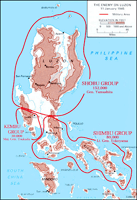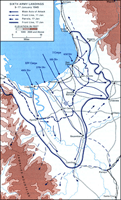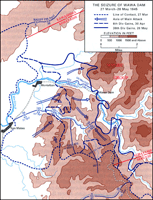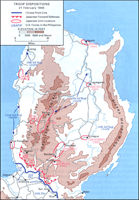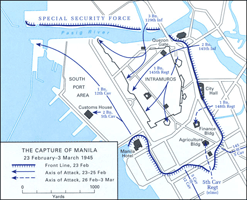| Join | Official Historian | City of Stamford | Blog | About Us | |
| Jewish Historical Society | Civil War Roundtable | Contact Us | |
|
|
|
|
The Stamford Historical Society PresentsPride and Patriotism: Stamford’s Role in World War II
|
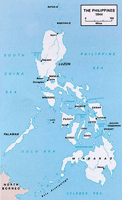 Large size of map of the Philippines, 1944 |
The Battle of Luzon was fought on the island of Luzon in the northern Philippines and pitted the Allied forces under General Douglas MacArthur against a large Japanese force under Japanese General Tomoyuki Yamashita. Because of the vital nature of the Philippines as a key route to sources of rubber and oil as well as the proximity of the islands to Japan, the Japanese High Command had reinforced the islands with a total of 430,000 troops distributed across the islands, 260,000 of which were on Luzon. The destruction of much of the Japanese carrier fleet earlier in June 1944 at the battle of the Philippine Sea and the subsequent loss of the remaining surface fleet in October at the Battle of Leyte Gulf, with the additional destruction of Japanese air power, left the defense of the Philippines in the hands of ground based forces.
As Leyte Island was still too distant for efficient preparations against Luzon, MacArthur made the decision to seize Mindoro, an island half the size of New Jersey and lightly defended by the Japanese. Mindoro was invaded by the U.S. forces on 15 December 1944. Despite kamikaze attacks, the landings were otherwise unopposed as there were only 1000 Japanese troops on the island. Airfields were seized by the end of that first day and preparations began for the taking of Luzon.
On 9 January 1945 General Krueger’s 6th Army landed at Lingayen Gulf with 175,000 men. The 8th Army commanded by General Robert L. Eichelberger landed at Subic Bay on 29 January and at Batangas on 31 January. Ultimately ten U.S. divisions and five independent regiments would see action on Luzon, making it the largest campaign of the Pacific War, involving more troops than the U.S. had used in North Africa, Italy or southern France. These attacks trapped the Japanese defenders in a giant pincer movement, but they put up bitter resistance at the battles for Manila, Balete Pass and the Cagayan Valley. Yamashita’s forces, despite their large number, were under-supplied with artillery, armor and other equipment, forcing him to fight a delaying action against the Americans with no real hope of victory. As such, Yamashita withdrew to mountainous zones, where the terrain afforded him some degree of protection and advantage.
Organized Japanese resistance ended on 28 June 1945, but pockets of enemy resistance continued for many months thereafter. American POWs were freed at Santo Tomas, Cabanatuan, Los Banos and Baguio. On 15 August General Yamashita surrendered with 50,500 troops.
Japanese casualties were about 230,000. The American forces suffered 10,380 killed and 36,550 wounded. There were also 93,400 non combat casualties including 260 deaths, most from disease.
| Peter Canzano Thomas Meehan Cortland Mehl Unit Citation, E Company, 161st Infantry Regiment |
From the U.S. Army Center of Military History:
The U.S. Army Campaigns of World War II: Luzon The Battle of Manila Pacific and Adjacent Theatre October 1944 (map) |
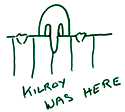 Introduction
Introduction
Veterans
Battles
Stamford Service Rolls
Homefront
Exhibit Photos
Opening Day
